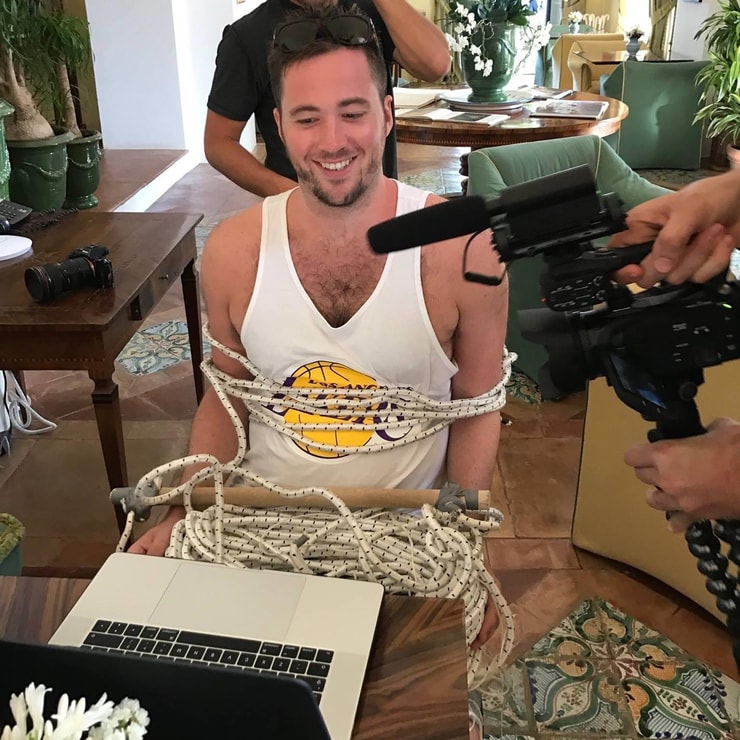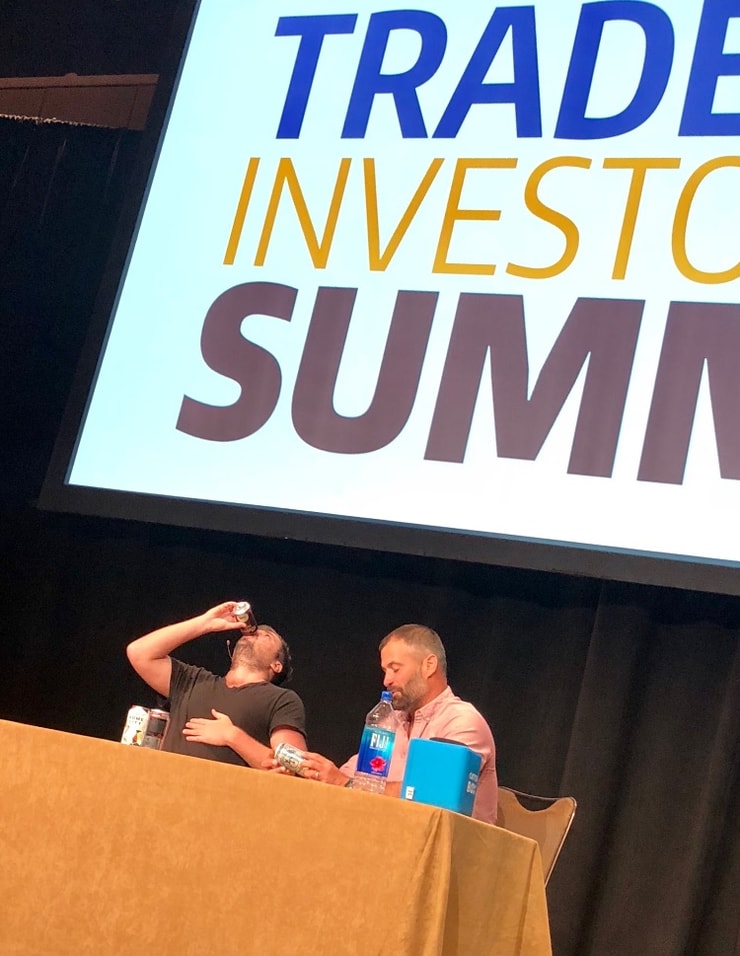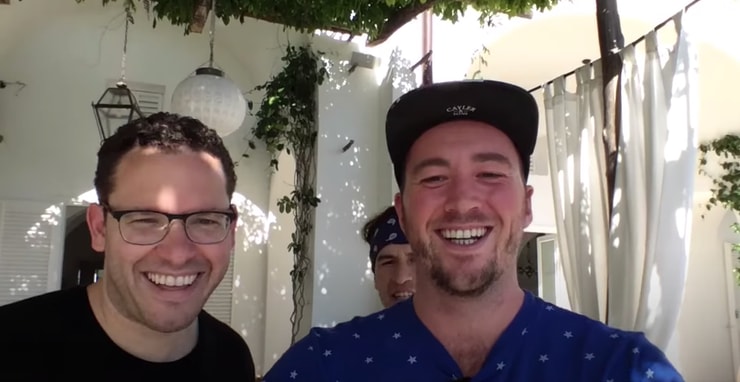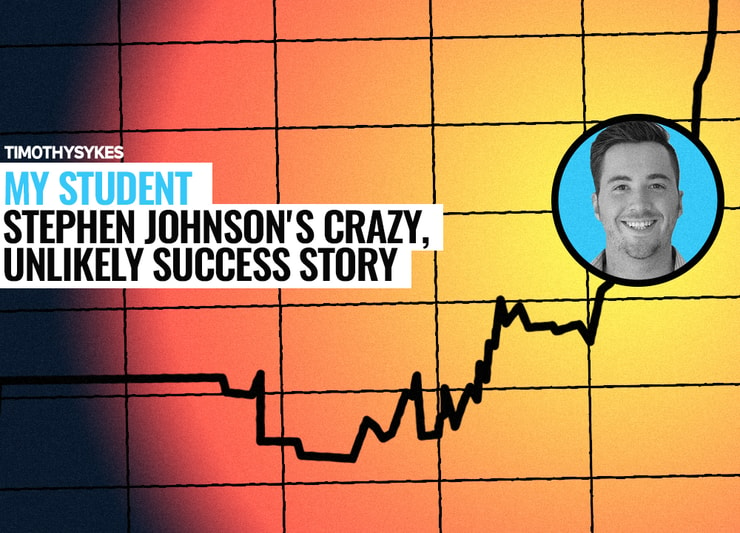There are two sides to Stephen Johnson…
On one hand, you’ve got a guy who understands the importance of education and responsibility.
Early in his trading career, he joined my Trading Challenge, and studied much as 10 hours per day … He also gained a following documenting his journey on YouTube and became the co-host of the SteadyTrade Podcast.
On the other hand, he’s got a long history as a drunken degenerate who overtrades.
I literally had to tie him up once to keep him from overtrading! But even that wasn’t enough to save him from himself … and the two massive $5K losses that almost ended his trading career.
I’ll tell the truth: I’ve had moments of doubt about whether Stephen would make it.
I’m happy to say that he’s faced his demons. Now, four years into his trading journey, he’s found consistency — and profits. In April he reports $10K* in profits. And in May he reports $15K.* He’s up $23K* in profits overall.
(*Please note: These results are not typical. Stephen has spent years developing exceptional skills and knowledge. Always remember trading is risky. Never risk more than you can afford.)
So how’d he go from constantly blowing up trades and acting impulsively to a self-sufficient, consistent, and profitable trader?
Here’s Stephen’s trading journey so far … including how he got smart, what made things click, and what waves of learning led to his current stability.
Table of Contents
How It All Started

About four years ago, Dubai-based Stephen Johnson wasn’t in the best place.
He’d just broken up with his long-term girlfriend. And he wasn’t feeling fulfilled at his marketing job. He was lonely and bored — not exactly the best combo for achieving great things.
Then, he came across my ad online.
Like Michael Goode, my first millionaire student,* Stephen was skeptical at first. He thought I was a scam … but he wasn’t scared off.
At heart, he was a gambler. He’d been good at poker … So he thought, why not give penny stocks a try?
So he decided to dedicate a year to it. After all, he didn’t have much else going on. The way he saw it, there were two options:
- If it was a scam, he could expose it.
- If it wasn’t a scam, he could potentially become rich and achieve a goal.
Either option seemed pretty OK and potentially a way to do good in the world. So he joined Pennystocking Silver and started following my lessons. Then he set up a YouTube channel and dedicated his Twitter feed to documenting his trading journey.
At first, he was mainly doing it out of boredom. He kept thinking:
Is this for me … should I give up?
But little by little, he started to develop a real interest in penny stocks.
Moving Forward
Stephen ended up joining the Trading Challenge and really started to dive deep into my videos.
“How to Make Millions” was the gateway drug for him, but he also got a lot from these too:
- “Trader Checklist Part Deux”
- “Pennystocking Framework”
- “Trading Tickers” by my top student Tim Grittani
Even though Stephen wasn’t really making money, his YouTube updates were hilarious — and he started to get a big following.
Before he knew it, he was enlisted as a co-host for the new SteadyTrade podcast. The idea was that he would pair up with Tim Bohen, the SteadyTrade Team (formerly StocksToTrade Pro) lead trainer. They’d present trading-related topics from the respective viewpoints of a trading veteran and a newbie.
Early on, Stephen was launched into trading stardom in the penny stock world … but did he find success too soon?
The Perils of Peaking Early
Stephen’s mindset definitely wasn’t in the right place yet.
He openly admits that at first, he was trading for the thrill, the intensity, and to get rich quick.
He was also a CRAZY overtrader. I’ve talked about the dangers of overtrading … Bad things can happen to your psyche and your account when you fall into the trap of chasing too much.
I even made an example out of Stephen when he came to a Market Mastery event in Positano … I tied him up to keep him away from his laptop so he couldn’t make bad trading decisions.
Getting Real

Stephen had passion. He had enough discipline to study. But he still kept breaking the rules.
His adrenaline-junkie ways landed him in hot water … again and again.
Then came the rock-bottom moment: a series of major losses, each totaling about $5K. They’re dissected in excruciating detail on the SteadyTrade podcast. Take time to check out these episodes — there are key lessons in both.
Stephen was on the verge of quitting. Even Bohen wondered if it was time for Stephen to take a little break.
But then some really good things started to happen.
First, he got smart about the importance of having a plan. Not just a trading plan, but a plan for his entire approach to trading.
Instead of focusing on money, he decided to focus on discipline first.
From there, his epiphanies were fast and furious…
How Stephen Made the Switch
He began to work on really focusing on the setups that worked for him — and being disciplined about cutting losses.
He switched his thinking from “I wanna get rich quick” to “money is the root of all evil.”
It might seem counterintuitive, but Stephen started to think that focusing on making money is the worst thing traders can do.
Just like how I use my “retired trader” mindset to trade safer, this shift worked for him. Once succeeding became a greater priority than making money, things changed for him.
And life-changing sessions with executive coach Kim Ann Curtin (who’s now a SteadyTrade podcast co-host) helped him get in touch with some emotional roadblocks. Check out the episodes:
- Episode 104: The Wall Street Coach in Action — Stephen Johnson’s First Coaching Session
- Episode 110: The Wall Street Coach in Action — Stephen Johnson’s Second Coaching Session
These were all simple changes, but they had a huge effect.
As Stephen puts it…
“It’s very, very simple. Just make a trading plan. Stick to a trading plan. Make sure your trading plan has a very good risk to reward.
Because ultimately, the other 95% of traders are sloppy. They’re sloppy, they’re gambling, they’re emotional.
After four years, I’ve become so much like a robot that I’m not sloppy, I’m not emotional. I’ll only trade a specific plan with a specific reward. That’s why I have an edge.”
How Stephen Johnson Trades Now

Stephen started to take the reins in his career, and his confidence shows.
As he says, “I’m a casino. I make the odds, I make the probabilities. Everyone else makes wrong probabilities but I make the right probabilities that only benefit me, and that’s how I make money.”
So how does he do it?
Stephen’s Variables
Stephen’s developed a no-BS approach to choosing stocks to trade. He’s got a specific set of indicators and conditions that trades must meet…
1. Top Percent Gainers
Is it a top percent gainer? This is non-negotiable.
2. Volume
How’s the volume? If there isn’t volume, the spike could be random.
3. Float
What’s the float? Stephen generally goes short. So if it’s low float, high volume, it’s dangerous … And if it’s low volume, high float, it could be an easy short.
Learn more about float here:
4. Long-Term Chart
How does the long-term chart look? Is there a distinct uptrend or downtrend? Is the company doing well overall?
5. Catalyst
Is there a catalyst? If so, does it have legs or is it fluff news?
6. Sector
Is the stock in a hot sector?
7. Financials
If you take a look on Yahoo! Finance or StocksToTrade, does it look like the company is making money? How are its earnings, how’s its revenue?
8. SEC Filings
Are there any signs of dilution, like offerings?
9. Intraday Chart
What are the highs and the lows?
Go Long or Go Short?
Here’s what Stephen Johnson thinks … These variables can help you make that call on whether to go long or short.
Say you’re looking at these nine variables … If all of them are bullish, it’s probably a good idea to go long. And if they’re all bearish, it’s a good indication that you should go short.
If it’s six or seven bearish variables, you might still go short, but you’d really keep a tight risk/reward…
But if it’s five out of nine? Too hard to predict … skip the trade.
Using These Variables
According to Stephen, once you understand these variables, they’re easy. Until then, it’s “a puddle of confusion.”
It took Stephen about a year to figure out these variables. Then it took another year to actually implement them.
These days, Stephen can scan through this list with any given stock in about five minutes. He also only trades for one to two hours per day, then proceeds to live his life…
But getting to that point took a LOT of work.
Early on, he’d study as many as seven hours a day on weekdays — sometimes even more on the weekends. And that’s when he was consistently losing! But it’s all part of the process that helped him find consistency.
Don’t have that much time to study? Stephen’s got advice: “Suck it up! Wake up at 4 a.m. like Tim Bohen if you want to study.”
Here’s what Stephen thinks of the current market: “Just when you thought the market couldn’t get crazier, it got much crazier.”
We’re seeing stocks with volumes of 50 million, 300 million, 400 million shares traded on the day.
That’s insanity. You’ve got to be prepared in a market like this. If you haven’t seen it, “The Volatility Survival Guide” is vital viewing to help you prepare for trading through it.
Stephen’s approach has been to look for those huge gainers and filter through his variables. And since he goes short often, he looks for signs of weakness … Is the daily chart weak? Has it failed when it gapped up before? Is the volume down?
The strategy’s working for him: Stephen reports making $10K in April and $15K in May.* Check out his profit chart on Profit.ly. And you can see his Profit.ly page here.
Yeah, Stephen’s had a few awesome months as a trader … but he’s worked hard for it. His story shows that if you’re willing to stick with it and keep learning and improving, it’s possible to find consistency!
Stephen Johnson’s Advice for New Traders
If Stephen could go back and knock some sense into himself early on, what would he say?
1. Believe in Yourself
Stephen says, “Have an unshakable belief in yourself. Nobody is going to believe in you except for you.”
Your mom, your friends, your coworkers — you can’t count on them to be your cheerleaders. You’ve got to believe in yourself first. You need that passion and conviction to stick with it for the long haul.
2. Don’t Skimp on Study Time
In your early days as a trader, there will be a lot of trial and error as you figure out how to look at multiple variables in parallel. It’s clumsy at first. Take the time to study and develop skills.
3. Don’t Make the Same Mistakes
You’re going to make mistakes as a trader. But try to learn from them and not make the same mistakes over and over. If you’re hitting your head against the wall, falling down the same rabbit hole … you need to take a different approach.
4. Find a Strategy That Suits You
Stephen doesn’t trade at all like me. But studying in my Challenge was still a really important step in his trading journey. My top students also teach webinars, which helped him gain exposure to a variety of strategies.
Ready to Find Your Path?
Trading isn’t a one-size-fits-all profession. Even though I teach specific strategies, I’m a huge advocate of developing your own style.
As I always say, I’m just your training wheels. I can teach you what I’ve learned in the past 20+ years in the market. But ultimately, you’ve gotta take what you learn and figure out how to apply it in a way that works for you.
That might be following a strategy similar to mine. It might be branching out to options like Mark Croock, or going short like Stephen Johnson.
No matter what path you choose, education is the gateway. Invest in your knowledge account first!
How are you inspired by this story? What’s your favorite part of Stephen’s journey? Leave a comment!






Leave a reply